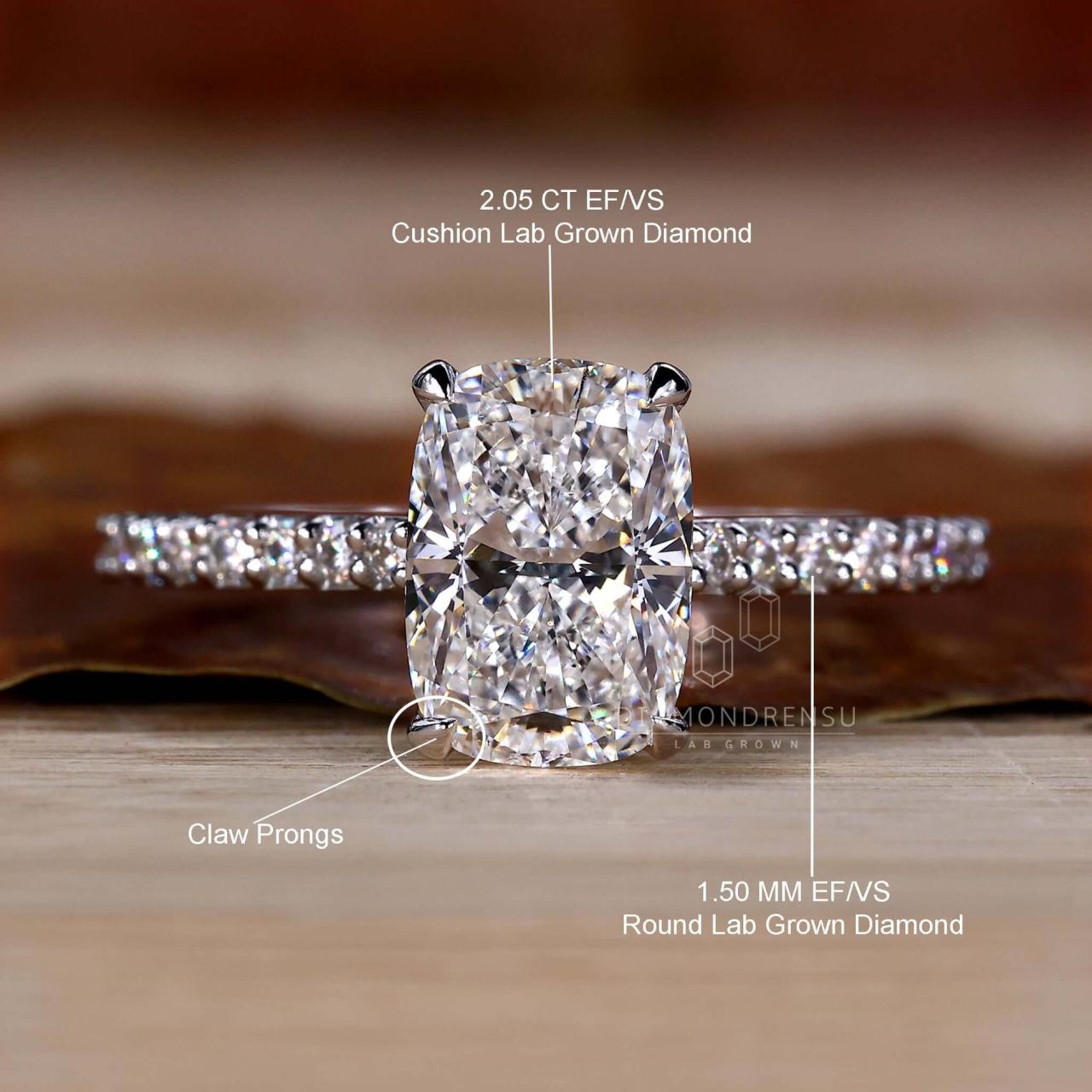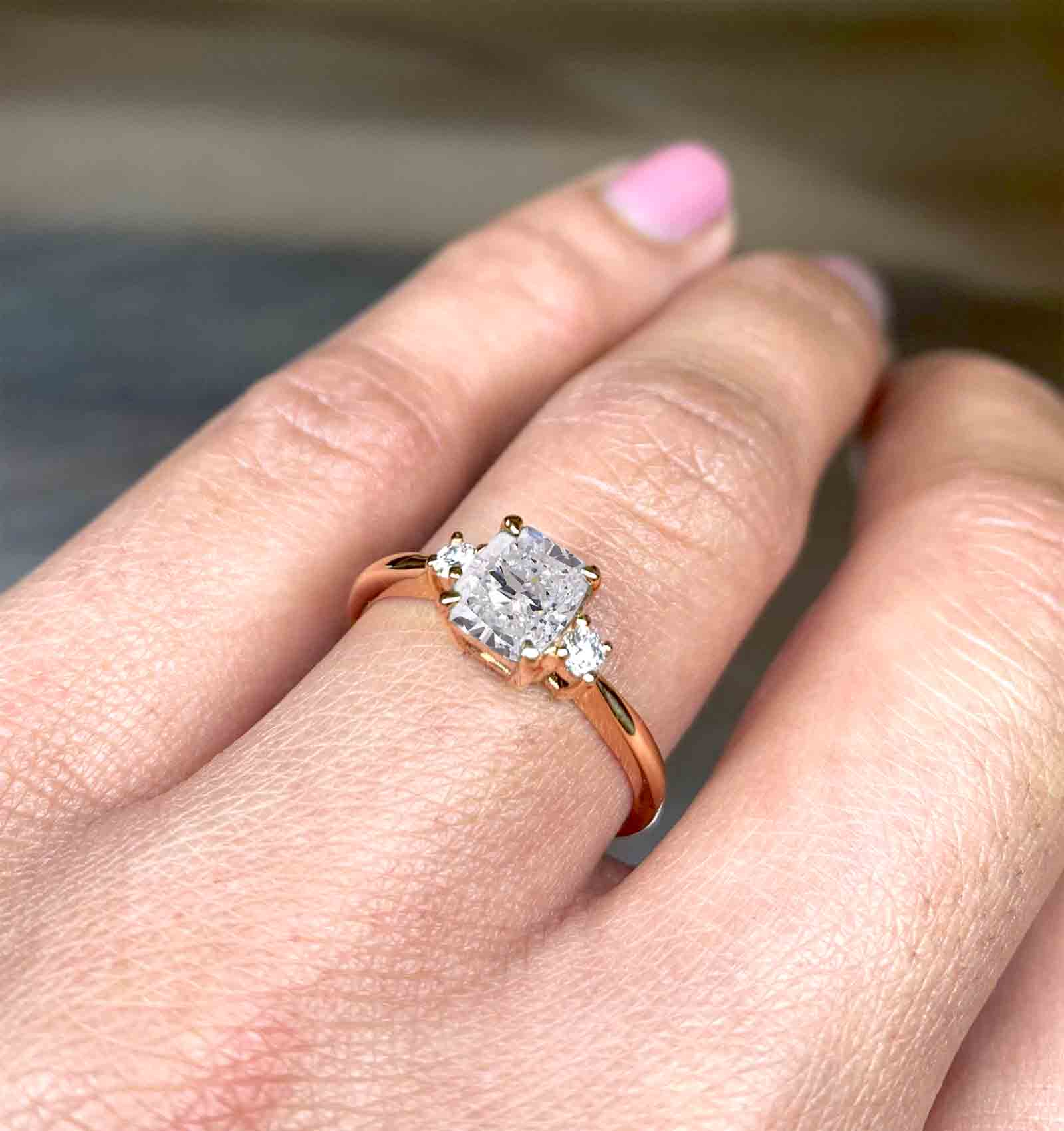In the glittering world of fine jewelry, diamonds have long stood as the ultimate symbol of love, commitment, and timeless elegance. For centuries, the allure of these magnificent stones, born deep within the Earth’s mantle, has captivated hearts and adorned the most cherished moments. However, the landscape of luxury is evolving, ushering in an era where ethical considerations, environmental consciousness, and cutting-edge technology redefine what it means to own a diamond. At the forefront of this revolution stands the lab-grown diamond, and within this exciting new frontier, the 2.5 carat lab-grown diamond ring emerges as a truly compelling and magnificent choice.
A 2.5 carat diamond is, by any standard, a significant stone. It’s a statement, a focal point, and a breathtaking display of brilliance and fire. When this impressive size is combined with the inherent advantages of a lab-grown origin, the result is a piece of jewelry that is not only visually stunning but also deeply resonant with the values of the modern consumer. This article delves into the multifaceted appeal of the 2.5 carat lab-grown diamond ring, exploring its beauty, ethical foundation, environmental benefits, and unparalleled value.
The Allure of 2.5 Carats: A Statement of Grandeur
Let’s begin with the sheer presence of a 2.5 carat diamond. In the realm of engagement rings, where size often matters, 2.5 carats strikes a perfect balance. It’s undeniably substantial, commanding attention and admiration without being ostentatious. This size offers exceptional visual impact, making the diamond appear prominent and luxurious on any hand. Whether set in a classic solitaire, embraced by a delicate halo, or flanked by accent stones, a 2.5 carat diamond has ample surface area to showcase its cut, clarity, and color, allowing its brilliance to truly shine.
For those dreaming of a substantial diamond that feels both luxurious and sophisticated, the 2.5 carat mark is often the sweet spot. It’s large enough to be a significant heirloom piece, a conversation starter, and a tangible representation of a momentous occasion. Choosing a lab-grown diamond of this size further enhances its appeal, making such a grand statement more attainable and aligned with contemporary values.
The Miracle of Modern Science: What Exactly is a Lab-Grown Diamond?
Before diving deeper, it’s crucial to understand what a lab-grown diamond truly is. Dispelling common misconceptions, a lab-grown diamond is not a simulant, like cubic zirconia or moissanite. It is a real diamond, identical in every chemical, physical, and optical property to its mined counterpart. Both are composed of pure carbon atoms arranged in a crystal lattice structure. The only difference lies in their origin: one is formed beneath the Earth’s surface over billions of years, while the other is created in a highly controlled laboratory environment in a matter of weeks.
There are two primary methods for growing diamonds in a lab:
- High-Pressure/High-Temperature (HPHT): This method mimics the natural diamond formation process, using extreme pressure and heat to crystallize carbon from a metal flux around a diamond seed.
- Chemical Vapor Deposition (CVD): In this technique, a small diamond seed is placed in a vacuum chamber, and carbon-rich gases are introduced. These gases break down into plasma, allowing carbon atoms to attach to the seed, layer by layer, growing a new diamond.
Both methods produce authentic diamonds that are graded by the same independent gemological laboratories (like IGI and GIA) using the same "4 Cs" (Cut, Color, Clarity, Carat Weight) standards as mined diamonds. This means a 2.5 carat lab-grown diamond possesses the same mesmerizing fire, sparkle, and durability that has made diamonds legendary.
The Ethical Imperative: A Conflict-Free Promise
Perhaps one of the most compelling reasons to choose a lab-grown diamond, especially one of significant size like 2.5 carats, is its unimpeachable ethical provenance. The history of mined diamonds has, unfortunately, often been intertwined with human rights abuses, forced labor, and funding of armed conflicts, leading to the term "blood diamonds." While initiatives like the Kimberley Process have aimed to curb this, the supply chain for natural diamonds can still be complex and opaque.
Lab-grown diamonds, by contrast, offer a transparent and unequivocally conflict-free alternative. They are created in controlled environments where labor practices are regulated, and the origin of the diamond is always known. This allows consumers to purchase a magnificent 2.5 carat diamond with complete peace of mind, knowing that its beauty is untainted by human suffering or exploitation. For a generation increasingly conscious of their purchasing power’s impact, choosing a lab-grown diamond is a powerful statement of integrity and social responsibility.
Environmental Stewardship: A Sustainable Sparkle
Beyond ethics, the environmental impact of diamond mining is a significant concern. Large-scale mining operations involve extensive land disruption, deforestation, habitat destruction, and considerable energy consumption, often leading to significant carbon footprints and water pollution.
Lab-grown diamonds present a far more sustainable and eco-friendly option. While they do require energy to produce, the environmental footprint is significantly smaller than that of traditional mining. Many lab-grown diamond producers are actively investing in renewable energy sources and sustainable practices, further reducing their ecological impact. Choosing a 2.5 carat lab-grown diamond means adorning oneself with a symbol of love that also reflects a commitment to protecting our planet. It’s luxury that doesn’t cost the Earth, offering a guilt-free sparkle that aligns with a greener future.
Unparalleled Value and Accessibility: More Carats for Your Conscience
One of the most practical and appealing advantages of lab-grown diamonds, particularly at the 2.5 carat mark, is their exceptional value. Due to the absence of the immense costs associated with mining, exploration, and the complex supply chain of natural diamonds, lab-grown diamonds are typically priced significantly lower—often 50-70% less—than their mined counterparts of comparable quality.
This price differential is transformative. It means that a 2.5 carat lab-grown diamond, which might have been prohibitively expensive as a mined diamond, becomes a realistic and attainable dream. Consumers can now acquire a larger, higher-quality stone (better cut, color, or clarity) within their budget, or allocate savings to other aspects of their lives. For those seeking a substantial and visually impressive diamond without compromising on quality or breaking the bank, the 2.5 carat lab-grown option offers unparalleled financial wisdom. It democratizes luxury, making grand gestures of love more accessible.
The Beauty and Brilliance: The Same Dazzling Spectacle
Ultimately, a diamond’s primary appeal lies in its breathtaking beauty and unmatched brilliance. As established, a lab-grown diamond is optically, chemically, and physically identical to a mined diamond. This means a 2.5 carat lab-grown diamond possesses the same dazzling fire, scintillating sparkle, and radiant brilliance that has made diamonds the most coveted gemstone in the world.
The "4 Cs" apply equally, allowing consumers to select a diamond with the perfect combination of cut, color, clarity, and carat weight that suits their personal preferences and budget. A well-cut 2.5 carat lab-grown diamond will reflect light with exceptional intensity, creating a mesmerizing play of light that is indistinguishable to the naked eye from a mined diamond of similar grade. Its substantial size only amplifies this visual spectacle, ensuring that every facet catches the light and mesmerizes observers.
Choosing Your Perfect 2.5 Carat Lab-Grown Diamond Ring
When selecting a 2.5 carat lab-grown diamond ring, consider the following:
- Certification: Always ensure the diamond comes with a grading report from a reputable independent gemological laboratory like IGI (International Gemological Institute) or GIA (Gemological Institute of America). These reports detail the diamond’s 4 Cs, providing assurance of its quality.
- The 4 Cs: While 2.5 carats is impressive, don’t overlook the other Cs. A superb cut is paramount for maximizing brilliance. Aim for an excellent or ideal cut grade. For color, consider a G or H for a nearly colorless appearance, or even an F or E if your budget allows. For clarity, VS1 or VS2 typically offers eye-cleanliness at a good value.
- Setting Style: The right setting will enhance the beauty of your 2.5 carat diamond.
- Solitaire: A classic choice that allows the diamond to be the undisputed star.
- Halo: Surrounding the center stone with smaller diamonds, a halo can make the 2.5 carat diamond appear even larger and add extra sparkle.
- Three-Stone: Flanked by two smaller diamonds, this setting symbolizes the past, present, and future.
- Pave: Diamonds along the band add extra brilliance.
- Metal Choice: Platinum and white gold are popular choices that complement the diamond’s brilliance. Yellow and rose gold offer a warmer, vintage feel.
Conclusion: The Future is Brilliant
The 2.5 carat lab-grown diamond ring stands as a powerful testament to the evolution of luxury. It embodies a convergence of scientific innovation, ethical responsibility, environmental consciousness, and undeniable beauty. For those who seek a magnificent diamond that makes a grand statement, while also reflecting their values, this choice is unparalleled.
It’s more than just a piece of jewelry; it’s a symbol of modern love – a love that is not only profound and enduring but also responsible and forward-thinking. As consumers increasingly prioritize transparency, sustainability, and ethical sourcing, the lab-grown diamond is not just an alternative; it is quickly becoming the preferred choice for discerning individuals. The 2.5 carat lab-grown diamond ring is not merely an object of desire; it is the zenith of modern luxury, offering a brilliant future for both its wearer and the world.


